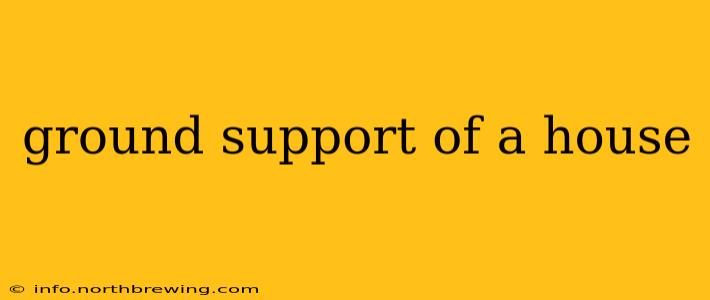The ground beneath your house plays a far more significant role than simply providing a level surface. Understanding how your house interacts with the ground—its ground support—is critical for ensuring structural integrity, longevity, and preventing costly repairs down the line. This comprehensive guide explores the various aspects of ground support for your house, addressing common questions and concerns.
What are the different types of ground support for a house?
Houses utilize various methods of ground support, each suited to different soil conditions and building designs. The primary types include:
-
Spread Footings: These are large, flat concrete pads placed beneath the foundation walls or columns. They distribute the weight of the structure over a wider area, minimizing pressure on the soil. This is a common solution for houses built on stable, firm soil.
-
Pier and Beam Foundations: This system uses concrete piers driven into the ground to support the structure's weight. Beams are then laid atop the piers, forming the foundation upon which the house rests. This method is ideal for areas with expansive soil or sloping terrain.
-
Slab-on-Grade Foundations: In this design, a concrete slab is poured directly onto the ground, forming the foundation. This is a cost-effective solution for stable soil conditions but is less adaptable to sloping land or unstable ground.
-
Basement Foundations: Basements provide a significant amount of below-ground support. The walls of the basement act as retaining walls, while the floor acts as a slab foundation. This offers ample space for storage and other utilities, but it requires careful consideration of water drainage and waterproofing.
How do I know what type of ground support my house has?
Determining your house's ground support system typically involves a visual inspection of the foundation and a review of building plans (if available). Look for the following indicators:
- Visible foundation walls: Exposed foundation walls suggest spread footings or a basement.
- Visible piers or columns: The presence of piers or support columns points towards a pier and beam system.
- Absence of visible foundation elements: A slab-on-grade foundation may have minimal visible elements, though expansion joints might be present.
- Crawlspace access: Access to a crawlspace can reveal the underlying support structure.
What problems can occur with poor ground support?
Insufficient or inadequate ground support can lead to various structural issues, including:
- Foundation settling or cracking: Uneven settling of the foundation can cause cracks in walls, floors, and other structural elements.
- Water damage: Poor ground support can disrupt drainage patterns, leading to water accumulation around the foundation and subsequent water damage.
- Pest infestations: Gaps or cracks in the foundation can provide entry points for termites and other pests.
- Structural instability: In severe cases, inadequate ground support can lead to significant structural instability, posing a safety risk.
How can I prevent problems with my house's ground support?
Proactive measures can significantly reduce the risk of ground support-related problems:
- Regular inspection: Conduct regular inspections of your foundation for cracks, settling, or other signs of damage.
- Proper drainage: Ensure proper drainage around your foundation to prevent water accumulation. Install gutters and downspouts to divert water away from the house.
- Landscaping considerations: Avoid planting trees or shrubs too close to your foundation, as their roots can damage the ground support.
- Professional assessment: If you suspect problems with your ground support, consult a structural engineer or foundation specialist for a thorough assessment.
What are the signs of foundation problems related to ground support?
Several visual signs can indicate foundation problems stemming from ground support issues:
- Cracks in walls or floors: These can range from hairline cracks to larger, more significant fissures.
- Sticking doors or windows: Uneven settling can cause doors and windows to become difficult to open or close.
- Sloping floors: Noticeable slopes in the floors suggest uneven settling of the foundation.
- Gaps around doors and windows: These gaps can indicate settling or movement of the foundation.
This information provides a general overview. Specific ground support solutions and potential problems vary significantly based on location, soil type, and building design. Always consult with qualified professionals for advice tailored to your specific situation. Addressing ground support issues proactively can save you significant costs and ensure the long-term stability and safety of your home.
